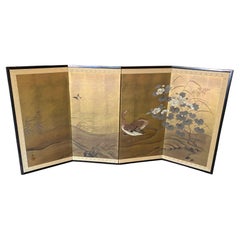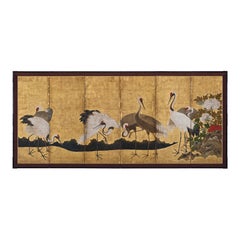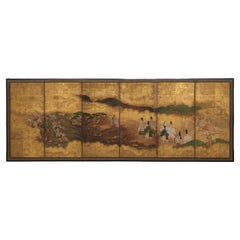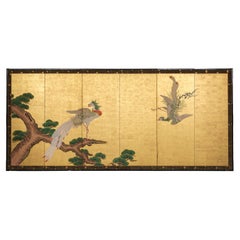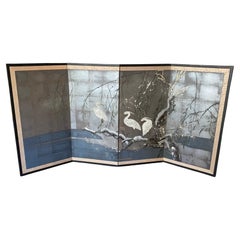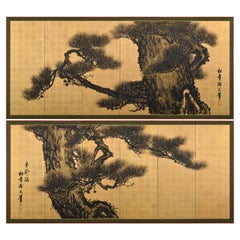Japanese Paintings and Screens
to
134
486
182
872
47
23
9
1
120
349
403
47
178
79
20
25
3
23
10
1
5
14
10
2
494
482
424
331
320
1,590
1,420
919
446
132
919
916
917
29
3
2
2
1
Place of Origin: Japanese
Japanese Asian Signed Four Panel Folding Byobu Screen Landscape Flowers & Geese
Located in Studio City, CA
A gorgeous four-panel Showa Period Japanese Byobu folding screen depicting a nature landscape scene with a two wild geese frolicking among the blossoming spring flowers as another co...
Category
20th Century Showa Japanese Paintings and Screens
Materials
Gold Leaf
17th Century Japanese Screen. Cranes and Peonies. Edo period.
Located in Kyoto, JP
Cranes and Peonies
Anonymous, Kano School.
Edo period, second half of the 17th century.
Six-panel Japanese screen. Ink, pigment gofun and gold leaf on paper.
This Japanese screen...
Category
Mid-17th Century Edo Antique Japanese Paintings and Screens
Materials
Gold Leaf
Mid-size 6-panel byôbu 屏風 with a scene from The Tale of Genji
Located in Amsterdam, NL
A refined medium-sized six-panel byôbu (folding screen) showcasing a classical autumn court scene from chapter 7 of The Tale of Genji (Genji Monogatari), titled Momiji no Ga (The Aut...
Category
17th Century Antique Japanese Paintings and Screens
Materials
Metal, Gold Leaf
Tall 6-panel byôbu with phoenixes attributed to Kanô Isen’in Naganobu
By Kano Isen'in Naganobu
Located in Amsterdam, NL
An exquisite, tall six-panel byôbu (folding screen) featuring a painting attributed to Kanô Isen’in Naganobu (1775–1828) depicting a pair of phoenixes (hô’ô) and a section of a large...
Category
Early 19th Century Antique Japanese Paintings and Screens
Materials
Metal, Gold Leaf
Japanese Asian Signed Four Panel Folding Byobu Screen Herons in the Winter Snow
Located in Studio City, CA
A gorgeous four-panel Showa Period Japanese Byobu folding screen depicting a nature landscape scene with a group of Herons frolicking in the snow covered bare Winter branches of a la...
Category
Mid-20th Century Showa Japanese Paintings and Screens
Materials
Silver Leaf
Circa 1900 Japanese Pine Screen Pair. Aged Dragons by Suzuki Shonen.
Located in Kyoto, JP
Suzuki Shonen (1848-1918)
Aged Dragons
A pair of six-panel Japanese screens. Ink and gold leaf on paper.
Dimensions: Each Screen: H. 170 cm x 378 cm (67" x 149")
As with the pair...
Category
Early 20th Century Meiji Japanese Paintings and Screens
Materials
Gold Leaf
Early 20th Century Japanese Screen. Flowers of the Four Seasons.
Located in Kyoto, JP
Anonymous
Flowers of the Four Seasons
A four-panel Japanese screen. Ink, gofun and pigments on gold leaf.
This Japanese screen is a rich visual celebration of the flowers of the fo...
Category
Early 20th Century Taisho Japanese Paintings and Screens
Materials
Gold Leaf
Japanese Asian Signed Four-Panel Folding Byobu Showa Screen Tales of the Genji
Located in Studio City, CA
A gorgeous four-panel Japanese Byobu folding screen depicting a landscape scene from the classic Japanese narrative "Tales of the Genji" featuring Lady Murasaki the Japanese novelist...
Category
20th Century Showa Japanese Paintings and Screens
Materials
Gold Leaf
Japanese Falconry Watercolor Panels, Set of Three
Located in Bradenton, FL
Set of Three Hand-Painted Japanese Watercolor Panels depicting falconry scenes, dating from the early 20th century. Each vertical panel features a meticulously rendered falcon perche...
Category
Early 20th Century Other Japanese Paintings and Screens
Materials
Paint, Paper
Japanese Asian Signed Four-Panel Folding Byobu Showa Mountain Landscape Screen
Located in Studio City, CA
A gorgeous four-panel Japanese Byobu folding screen depicting a natural landscape scene with a small village and boats on the shimmering water. The dark, rich colors, gold leaf, and ...
Category
20th Century Showa Japanese Paintings and Screens
Materials
Gold Leaf
Japanese Asian Signed Four-Panel Folding Byobu Nature Tree Blossom Bird Screen
Located in Studio City, CA
A gorgeous four-panel Japanese Kyoto Byobu folding screen depicting a natural landscape scene with blossoming tree flowers, birds and a flowing river or lake. The rich colors, gold ...
Category
Mid-20th Century Showa Japanese Paintings and Screens
Materials
Gold Leaf
18th Century Japanese Rinpa Screen. White Chrysanthemums. School of Korin.
Located in Kyoto, JP
School of Ogata Korin
White Chrysanthemums
18th Century, Edo period.
A two-panel Japanese screen. Ink, color, gofun and gold leaf on paper.
Dimensions: H. 171 cm x W. 188 cm (67.5” x 74”)
On this two-panel Japanese screen we see blooming chrysanthemums, a flower which embodies the essence of autumn in Japan. Here the traditional floral theme has been simplified and stylized. The bright colors and asymmetrical composition against the delicate gold leaf create a luxurious and ornate work of art. Its background, a strikingly patinated grid of gold leaf, denies any sense of place or time and imbues everything with an ethereal glow. The leaves and stems of the plants are nothing more than pools of mottled color and ink without any outline whatsoever. These are typical Rinpa adaptations of traditional ink painting methods; tarashikomi, or diluted washes of color blended while very wet, and mokkotsu, or “bonelessness,” which creates forms without exterior outlines. The relief work of the rounded flower petals has been obtained by the moriage process (a mixture based on ground shells modeled on the surface of the paper).
On the lower right of the screen, the siganture “Hokyo Korin Jakumyo” and the “Hoshuku” seal can be read. Korin is Ogata Korin, famed for the Irises (Nezu Museum) and Red and White Plum Blossom (MOA Museum of Art) folding screens, both National Treasures. Korin worked in both Kyoto and Edo in the mid-Edo period. Korin was using the art name “Jakumyo” just after he received the Hokyo level, which was in 1701.
This particular screen was published in May of 1961 in the Japanese Sansai Fine Art Magazine*. An in depth article accompanies the photograph of the screen and and a photograph of the signature and seal. This article devotes much of its body to discussing the moriage technique, how it enlivens the chrysanthemum flowers and Korin’s specific skill in using the technique. The article goes on to discuss the most famous works of Korin, utilizing this technique, which were known at the time. Specifically a two-panel screen held in the Honolulu Museum which was discovered in the store-house of Takahashi Soan. A two-panel screen pair which the Nakano family own. A two-panel screen pair with chrysanthemums in moriage in fan designs owned by the Nomura family. Also a small folding screen featuring chrysanthemums held in the Yamato Bunkakan. The article goes on to say that this particular two-fold screen came from the Nijo family. Korin is known to have had a strong connection with the aristocratic Nijo family. The article explains that Korin received a lot of favors from the Nijo family and that this screen would have been gifted to them.
Since that time the Honolulu screen has been amended to ‘attributed to Ogata Korin’ and I do not know further details of the other 3 screens. Other Chrysanthemum screens...
Category
18th Century Edo Antique Japanese Paintings and Screens
Materials
Gold Leaf
Japanese Showa Six Panel Screen Tales of Genji on Gilt
Located in Rio Vista, CA
Early 20th century Japanese showa period six panel byobu screen depicting an artistic reinterpretation of a scene from the tales or Genji Monogatari. The miniature style of the paint...
Category
20th Century Showa Japanese Paintings and Screens
Materials
Silk, Wood, Paper
Japanese Showa Four Panel Screen Fruiting Pomegranate Tree
Located in Rio Vista, CA
Exquisite mid-20th century Showa period four panel folding byobu screen featuring a fruiting pomegranate tree over a dramatic cream toned background. Vivid ink and natural pigment co...
Category
20th Century Showa Japanese Paintings and Screens
Materials
Silk, Wood, Paper
Japanese Rare Antique Pair Hand Painted Birds And Blue Waters Wedding screens
Located in South Burlington, VT
A lovely antique pair (2) Japanese hand-painted six-panel folding screens byobu- each conceived in an attractive birds, trees, and blue waters motif. Likely given as a wedding gift...
Category
19th Century Meiji Antique Japanese Paintings and Screens
Materials
Wood, Paper
$760 Sale Price / set
20% Off
Japanese Edo Screen Kano School Isle of Immortals
Located in Rio Vista, CA
Fascinating 19th century Japanese Edo period six-panel byobu screen depicting the Isle of Immortals. The painting features white Manchurian cranes among pines and flowering plum cent...
Category
19th Century Edo Antique Japanese Paintings and Screens
Materials
Brass, Gold Leaf
Mid 18th Century Japanese Screen Pair. Crows & Pines by Unkoku Toshuku.
Located in Kyoto, JP
Unkoku Toshuku (1722-1779)
Crows and Pines
A pair of six-panel Japanese Screens. Ink and gold leaf on paper.
Dimensions: Each Screen: H. 170.5 cm x W. 375 cm
Haha-cho or mynah birds, whose forms resemble crows in artwork, were commonly depicted in Japanese art. These types of paintings were originally modeled on paintings attributed to the 13th century Chinese painter Muqi (Mokkei), whose art was enormously influential in Japan. Crows only became a theme among Japanese artists from the later 1500s onward. They likely were inspired by these imported Chinese paintings of myna birds, which are not native to Japan, substituting the native species of crow instead.
The best known early examples of the depiction of Japanese crows are two Momoyama screen...
Category
Mid-18th Century Edo Antique Japanese Paintings and Screens
Materials
Gold Leaf
Japanese Antique Pair Jade Green Mandarin Duck Screen Holders
Located in South Burlington, VT
A handsome pair of Japanese hand cast Mandarin Duck screen holders with highly detailed plumage possessing a lovely original jade green finish , early Taisho period, early 20th cen...
Category
Early 20th Century Meiji Japanese Paintings and Screens
Materials
Iron
Early 20th Century Japanese Nihonga Screen. Bamboo Forest.
Located in Kyoto, JP
Anonymous
Bamboo Forest
Early Taisho era. Circa 1910-1915.
Six-panel Japanese Screen. Mineral pigment, gofun and ink on silk.
A six-panel Japanese folding screen, painted on silk in...
Category
Early 20th Century Taisho Japanese Paintings and Screens
Materials
Silk
Edo period Japanese Screen. Tiger and Pine by Kishi Ganku.
Located in Kyoto, JP
Kishi Ganku (1749/1756-1838)
Tiger and Pine
A six-panel Japanese Screen. Ink on silver leaf.
The central focus of this Japanese screen is a large tiger, emerging from shadow, crou...
Category
Late 18th Century Edo Antique Japanese Paintings and Screens
Materials
Silver Leaf
Early 20th Century Japanese Cherry Blossom Screen by Kano Sanrakuki
Located in Kyoto, JP
Cherry Blossoms
Kano Sanrakuki (1898-1981)
Showa period, circa 1930
2-panel Japanese Screen
Color, gofun and gold leaf on paper
Against a backdrop of gold-leafed ground, the lichen covered trunk and branches of the life-sized cherry blossom tree reach out and beyond the confines of the pictorial surface. The overall composition has a feeling of flatness which draws emphasis to the surface and the three-dimensionality of the cherry blossoms. Painstakingly built-up layers of thickly applied shell-white gofun detail the voluminous blossoms and cover large areas of this tour-de-force of Japanese Nihonga painting. By simplifying the background, minimizing the number of colors and depicting the blossoms with such heavy relief, the artist has emphasized the stunning presence of the cherry tree. The type of tree depicted is the Yae-Zakura; a double-layered type of cherry blossom famed for its beauty and strength. When we think of Japanese cherry blossoms, the first thing that comes to mind is Somei Yoshino variety, which has a single flower with five almost white petals. This type is fragile and easily blown away by strong wind or rain. Most of the double-flowered cherry blossoms begin to bloom when the Somei-Yoshino falls, and the flowering period lasts longer than that of the Somei-Yoshino.
Kano Sanrakuki originally studied painting at the Kyoto City Arts and Crafts School under the tutelage of Yamamoto Shunkyo...
Category
Early 20th Century Showa Japanese Paintings and Screens
Materials
Gold Leaf
Japanese Chinese Asian 4 Panel Folding Byobu Screen Red Crowned Crane Landscape
Located in Studio City, CA
A gorgeous four-panel Japanese/Chinese/Asian Byobu folding screen depicting a landscape scene with a flock of playful red crown cranes (likely Manchurian cranes), a flowing river, an...
Category
Mid-20th Century Showa Japanese Paintings and Screens
Materials
Wood, Paint, Paper
19th Century Japanese Shunga Hand-Scroll, Katsukawa School
Located in Kyoto, JP
Shunga
Unknown artist
Meiji era, circa 1880
Hand-scroll mounted with 12 paintings
Ink, pigment and gofun on silk
Dimensions:
Each image measures H. 23.2 cm x W. 34.4 cm (9.15” x 13.5”)
The hand-scroll measures H. 28 cm x W. 540 cm (11” x 212”)
A set of 12 late 19th century Japanese Shunga paintings mounted as a hand-scroll. Two of the leaves bear the signature and seal ‘Setsuzan’, although we are unable to confirm the identity of the artist using this art name. 6 of the 12 images are taken almost directly from Katsukawa Shuncho’s late 18th century woodblock series, ‘Erotic Pictures...
Category
Late 19th Century Meiji Antique Japanese Paintings and Screens
Materials
Silk
Early 19th Century Japanese Screen. Cherry Blossom & Pheasants by Mori Tetsuzan
Located in Kyoto, JP
Mori Tetsuzan (1775-1841)
Pheasants and Cherry Blossoms
Two-fold Japanese screen. Ink, color, gofun, gold and silver on paper.
A two-fold Japanese bir...
Category
Early 19th Century Edo Antique Japanese Paintings and Screens
Materials
Gold Leaf
Pair of Red and White Plum Blossom Screens After Ogata Korin
Located in Rio Vista, CA
Amazing pair of 18th century Edo period style paintings of red and white plum blossoms after Ogata Korin (Japanese 1658-1716). One of the most famous paintings in Japan where it is r...
Category
20th Century Edo Japanese Paintings and Screens
Materials
Brass, Gold Leaf
Japanese Asian Pair of Large Six-Panel Folding Byobu Screens Mythical Landscape
Located in Studio City, CA
A beautiful, alluring, wonderfully composed and engaging hand-painted large pair of six-panel Japanese/Asian Byobu folding screens depicting an almost magical/ mythical village scene...
Category
18th Century Meiji Antique Japanese Paintings and Screens
Materials
Gold Leaf
Mid 19th Century Framed Japanese Painting. Mice & Millet
Located in Kyoto, JP
Obata Tosho (1812-1886)
Mice & Millet
Late Edo period, mid 19th Century
Framed Japanese Painting. Ink and color on paper.
Individually framed 19th century bird and flower paintin...
Category
Mid-19th Century Edo Antique Japanese Paintings and Screens
Materials
Paper
Circa 1700 Japanese Screen Pair, Cranes & Pines, Kyoto Kano School
Located in Kyoto, JP
Pines and Cranes
Anonymous. Kyoto Kano School.
Late 17th/early 18th centuries, circa 1700.
Pair of six-panel Japanese folding screens.
Ink, gofun, pigment and gold leaf on paper.
This bold composition presents two pine trees extending to the left and right across a gold leaf background. One tree is silhouetted against a green ground, golden clouds obscuring its true size, the other stretches across a stylized waterway. The pines are paired with Manchurian cranes with red crests and snow white plumage. Both have been highly auspicious motifs in East Asia since Chinese antiquity. Here the artist utilized fluid and instinctive ink brushstrokes to define the trunk, branches and tail feathers, in strong contrast to the precision and sharp angularity of the crane’s legs and beaks. The adoption of this vast metallic painting support required an unerring sense of design and composition, so that the negative space surrounding motifs could imply context for the otherwise floating pictorial elements. The brushwork detailing the trunks of the pines, the exaggerated dimensions of the pine trees and the strength and dynamism of the composition are all reminiscent of Kano Eitoku...
Category
Late 17th Century Edo Antique Japanese Paintings and Screens
Materials
Gold Leaf
Circa 1925. Taisho era Japanese Nihonga Screen. Camellia & Bamboo.
Located in Kyoto, JP
Anonymous
Camellia & Bamboo
Taisho era
Two-panel Japanese Screen. Mineral pigment, gofun and ink on silk.
A small Japanese Nihonga screen capturing...
Category
Early 20th Century Taisho Japanese Paintings and Screens
Materials
Silk
Japanese Antique Hand Painted Lotus And Blue Waters Screen Vibrant Colors
Located in South Burlington, VT
From our recent Japanese Acquisitions- Hard to Find Lotus Flowers
A stunning Japanese Antique Hand Painted six panel byobu screen on silk executed with lovely lotus flowers and vib...
Category
19th Century Meiji Antique Japanese Paintings and Screens
Materials
Gold Leaf
$1,320 Sale Price
20% Off
Large Japanese 2-Panel Byôbu 屏風 'Room Divider' with Painting of Bamboo & a Poem
Located in Amsterdam, NL
Beautiful, large two-panel byôbu (room divider) with a serene painting of red-leaved bamboo and rocks on an oxidized silver leaf background. Silver leaf continuously undergoes the process of oxidation, which creates a beautiful aged patina.
On the left an inscription from a ‘Zekku’ poem by the Chinese poet Yang Zai (1271?1323), titled: Shan shang zhu (bamboo (painted) on a fan).
Translated as :
Why would people plant a lot of bamboos?
The shade of a single culm is also beautiful.
In the autumn night it rocks on the wind,
And the fresh sound echoes in my dream.
Dated: Shôwa, the year kôshin (1938). Signature unknown...
Category
Early 20th Century Japanese Paintings and Screens
Materials
Other, Silver Leaf
Kiku to Hagi Byobu, Rinpa School Style, Edo Period.
Located in Point Richmond, CA
A Chrysanthemum and Bush Clover painting on gold leaf six-panel folding screen, painted with clusters of leafy green chrysanthemum plants with white blossoms having moriage relief petals of gofun growing amidst pink blossoming bush clover within a bunched bush clover garden fence rendered in lighter gold relief, all on a background entirely of rich gold leaf. These two flowers are symbolic of Japan and the autumn season. The classic patterned paper verso with a Naga Antiques...
Category
Early 1800s Edo Antique Japanese Paintings and Screens
Materials
Gold Leaf
Japanese Asian Signed Four-Panel Folding Byobu Showa Screen Tales of the Genji
Located in Studio City, CA
A gorgeous four-panel Japanese Byobu folding screen depicting a scene from the Classic Japanese narrative "Tales of the Genji". The vibrant, rich colors, gold leaf, and beautiful han...
Category
20th Century Showa Japanese Paintings and Screens
Materials
Gold Leaf
17th Century Japanese Screen. View of West Lake by Unkoku Toyo.
Located in Kyoto, JP
Unkoku Toyo (1612-1668)
View of West Lake
Pair of eight-panel Japanese Screens. Ink and gold wash on paper.
Dimensions: Each screen: H. 110 cm x W. 372 cm (43” x 147”)
This pair ...
Category
Mid-17th Century Edo Antique Japanese Paintings and Screens
Materials
Paper
Unique Contemporary Abstract Screen Painting inspiration from the Gutai art
Located in Fukuoka, JP
Unique Contemporary Abstract Screen Painting
A one-of-a-kind contemporary abstract painting executed on a folding screen, drawing bold inspiration from the pioneering Gutai art mov...
Category
20th Century Japanese Paintings and Screens
Materials
Acrylic, Wood, Paper
19th Century Japanese Screen, Deer in Spring, Maruyama Shijo School
Located in Kyoto, JP
A six-panel Japanese folding screen from the leading Maruyama-Shijo artist Okamoto Toyohiko (1773-1845). Simply featuring three deer and a few sprigs of foliage on a sumptuous gold-leaf background this work emphasizes naturalistic expression and a masterful use of negative space. Reduced to its most basic elements, the blank spaces inspire imagination and evoke the smells, sounds and even the weather of the scene. Whilst deer are traditionally depicted in association with autumn, here the green growth on the tops of the foliage indicates the season of spring. The work references Maruyama Okyo’s two-panel deer screen...
Category
Early 19th Century Edo Antique Japanese Paintings and Screens
Materials
Gold Leaf
Japanese Showa Four Panel Screen Prunus with Songbirds
Located in Rio Vista, CA
Spectacular late 20th century Japanese Showa period four panel byobu screen depicting blossoming spring prunus or plum trees with songbirds in flight. The screen features a dramatic ...
Category
20th Century Showa Japanese Paintings and Screens
Materials
Brass
Japanese Fine Pair Arts And Crafts Shoji Door Screens
Located in South Burlington, VT
Japan, a fine pair of two simple shoji bamboo doors or screens creating an arts and crafts look. The pair are hinged together for convenient display with attractive portals above; ...
Category
Early 20th Century Showa Japanese Paintings and Screens
Materials
Bamboo, Wood
$476 Sale Price
20% Off
Large Japanese 6-panel byôbu 屏風 (folding screen) with genre painting
Located in Amsterdam, NL
Fascinating large six-panel byôbu (folding screen) with a detailed genre painting on goldish silver leaf with different scenes of people at work in a rural mountain village during th...
Category
Early 20th Century Japanese Paintings and Screens
Materials
Silver Leaf
Japanese Edo Screen Portraits of the Thirty Six Immortal Poets
Located in Rio Vista, CA
Interesting 19th century Japanese Edo period six-panel byobu screen depicting the thirty six immortals of poetry (Sanjurokkasen). Each portrait is accompanied by their poems. The poe...
Category
19th Century Edo Antique Japanese Paintings and Screens
Materials
Wood, Paper
Stunning Set of Four 19th Century Edo Period Fusuma Door Decorative Panels
Located in Los Angeles, CA
A set of four fusuma (sliding door) panels from the 19th century, painted in ink and colors on gold leaf. The panels depict a blossoming cherry tree extending beyond a woven fence an...
Category
Late 19th Century Edo Antique Japanese Paintings and Screens
Materials
Gold Leaf, Brass
Early 20th Century Japanese Screen Pair - Ink Pine Trees on Gold
Located in Kyoto, JP
Imao Keisho (1902-1993)
Pine Trees
Early 20th Century, Circa 1930
Pair of six-panel Japanese screens. Ink on silk and gold leaf.
Dimensions: Each screen H. 67.5” x 148” (172 cm x 376 cm)
A pair of monumental six-panel Japanese pine screens by the renowned Nihonga artist Imao Keisho. Here Keisho entirely removed the background and brought the pine trees to the surface of the painting. This simplification of the elements makes the scene exceptionally direct and compelling and injects a very modern...
Category
Early 20th Century Showa Japanese Paintings and Screens
Materials
Gold Leaf
Meiji Era, Circa 1900 Japanese Screen Pair, Flowers & Birds of Spring & Autumn
Located in Kyoto, JP
Flowers & Birds of Spring and Autumn
Unknown artist.
Japan. Meiji period, circa 1900.
A pair of six-fold screens. Ink, color, gofun and gold leaf on paper.
Signed: Gaga S...
Category
1890s Meiji Antique Japanese Paintings and Screens
Materials
Gold Leaf
Mid-18th Century Japanese Screen Pair, One Hundred Flowers, Chrysanthemums
Located in Kyoto, JP
Omori Soun (b. 1704)
Chrysanthemums - One Hundred Flowers
A Pair of Six-fold Japanese Screens. Ink, color, gofun and gold leaf on paper.
Dating ...
Category
Mid-18th Century Edo Antique Japanese Paintings and Screens
Materials
Gold Leaf
Japanese Chinese Asian Large Six-Panel Folding Byobu Screen Mythical Landscape
Located in Studio City, CA
A gorgeous, strangely beautiful, unusually engaging, and alluring hand-painted large six-panel Japanese/Asian Byobu folding screen depicting an almost magical/ mythical nature scene ...
Category
18th Century Edo Antique Japanese Paintings and Screens
Materials
Gold Leaf
Antique Japanese Ebonized & Gilt Chinoiserie Decorated Six-Panel Screen c1920
Located in Big Flats, NY
***Reduced Delivery Rates - See Below or Click “Ask The Seller” to Request a Quote***
An antique Japanese Chinoiserie screen offers six ebonized and gilt decorated panels with a con...
Category
Early 20th Century Japanese Paintings and Screens
Materials
Wood
$1,160 Sale Price
20% Off
Circa 1920. Taisho era Japanese Nihonga Screen. Dahlias & Cockscomb.
Located in Kyoto, JP
Kawabe Kasho (b.1892)
Dahlias & Cockscomb
Taisho era. Circa 1920
Two-panel Japanese Screen. Mineral pigments and ink on silk.
This exquisite two-panel Japanese folding screen, pa...
Category
Early 20th Century Taisho Japanese Paintings and Screens
Materials
Silk
Antique Taisho Period Tanzaku Woodblock Print of Heron at Twilight by Seiko
By Seiko
Located in Philadelphia, PA
A fine antique Taisho period Japanese woodblock print.
Depicting a swooping heron above a riverbed with a thin sliver of a crescent moon in the background.
By Seikо̄. Seikо̄ is tho...
Category
Early 20th Century Taisho Japanese Paintings and Screens
Materials
Paper
19th Century Japanese Screen Pair. Flowers & Birds of the Four Seasons
Located in Kyoto, JP
Flowers & Birds of the Four Seasons
Pair of six-fold Japanese Screens. Ink, color, gofun and gold on paper.
Second half of the 19th Centur...
Category
Late 19th Century Meiji Antique Japanese Paintings and Screens
Materials
Wood, Paper
Japanese Byobu six panels screen on paper Edo Period 19th century
Located in Paris, IDF
Beautiful Edo period Japanese Byobu six panel screen from the early 19th century depicting scenes from the Tale of Genji, with pavilions, gardens and women of the court wearing kimon...
Category
19th Century Japonisme Antique Japanese Paintings and Screens
Materials
Paper
Japanese antique screen - EDO period - Willow over a stream
Located in Prahran, Victoria
Antique Japanese 6 panel screen from the early Edo period (C1650). One of a pair (both available). This magnificent golden screen shows...
Category
1650s Edo Antique Japanese Paintings and Screens
Materials
Gold Leaf
Japanese Showa Four Panel Screen Flower Vases on Silk
Located in Rio Vista, CA
Charming Japanese four-panel Showa period byobu screen depicting colorful floral arrangements in various vases and baskets. The hand-painted screen features vibrant natural color pig...
Category
20th Century Showa Japanese Paintings and Screens
Materials
Brass
Mid 19th Century Japanese Screen Pair. Flowers & Birds of the Four Seasons.
Located in Kyoto, JP
Shioka Sorin (1781-1850)
Flowers & Birds of the Four Seasons
Pair of six-panel Japanese Screens. Ink, gofun and pigments on silk.
Dimensions (each screen): H. 91.5cm x W. 285cm (3...
Category
Mid-19th Century Edo Antique Japanese Paintings and Screens
Materials
Silk
Japanese Meiji Four Panel Screen Wild Geese Over Reeds
Located in Rio Vista, CA
Muromachi period inspired Japanese four panel byobu screen depicting wild geese in flight over reeds. The 19th century Meiji period painting bears an artist's signature Chisokuken. C...
Category
19th Century Meiji Antique Japanese Paintings and Screens
Materials
Brass
Japanese Screen Painting, Circa 1700 'Tales of Ise' by Tosa Mitsusuke
By Tosa Mitsusuke 1
Located in Kyoto, JP
A six-fold Japanese screen by Tosa Mitsusuke (1675-1710), Japan 17th-18th century, Edo period.
The signature reads Shoroku-i ge Tosa sa Konoe Shogen Mit...
Category
Late 17th Century Edo Antique Japanese Paintings and Screens
Materials
Gold Leaf
Byobu - Japanese Screen "Kano School" Gold Leaf
By Japanese Studio
Located in Brescia, IT
Japanese Kano School Six Panel Screen: Landscape with Beautiful and Elegant Cranes near the River, with Pines and Sakura.
Hand painted with mineral pigments and inks on vegetable pap...
Category
Late 18th Century Edo Antique Japanese Paintings and Screens
Materials
Gold Leaf
Japanese Edo Two Panel Screen Meandering Stream with Birds
Located in Rio Vista, CA
Weathered Japanese late 18th century Edo period two-panel byobu screen depicting a meandering stream with sparrows in flight. Crafted with natural ink and color pigments on mulberry ...
Category
18th Century Edo Antique Japanese Paintings and Screens
Materials
Brass
Japanese Matching Set of Two Fine Birds And Dragonfly Shoji Doors Screens
Located in South Burlington, VT
Japan, a fine set of two shoji "Birds and Dragonfly" bamboo doors or screens recently acquired from a Japanese private collector. The hand carved boards are artistically cut and ins...
Category
Early 20th Century Taisho Japanese Paintings and Screens
Materials
Bamboo, Wood
Japanese Showa Four Panel Screen Fall Persimmon Tree
Located in Rio Vista, CA
Beautifully weathered Japanese Showa period four-panel byobu screen depicting a persimmon tree in the fall. Ink and natural color pigments on light gold silk background. Made in the ...
Category
20th Century Showa Japanese Paintings and Screens
Materials
Brass
Japanese Four Panel Garden Screen with Koi, Iris, & Turtles
Located in South Burlington, VT
Unusual Japanese Four Panel Garden Screen, Mint Condition
Japan, a superb four-panel silk screen byobu depicting a panoramic garden replete with koi, turtles, Iris nestled near a walking bridge and wooden roofed shelter. This attractive screen dates to the early Taisho period.
It is signed Tae.
It is beautifully hand painted with a handsome gold natural light background by a skillful artist painter and is signed with inscription and seal in lower right corner:
Dimensions: 69 inches high and 113 inches wide extended.
Enticing and rare subject matter, this simple rendition of a serene nature setting and size of painting is skillfully and tastefully rendered in mineral paint pigments on silk and with muted soft green and off-white tones depicting a serene nature walk. Perhaps this is someone's dream tea garden. A red lacquered wood perfectly frames this serene and tasteful composition.
Photographed in natural light.
Lifetime guarantee of authenticity: All of our Asian works of art come with our Lifetime Authenticity Guarantee. We are members of the North American Japanese Garden...
Category
Early 20th Century Taisho Japanese Paintings and Screens
Materials
Silk
$7,600 Sale Price
58% Off
Recently Viewed
View AllMore Ways To Browse
Lattice Panel Wood
Hanging Japanese Screen
Japanese Lattice
Japanese 19th Century Meiji Period Silk Painting
Japanese Buddhist Screen
Japanese Carved Screen
Japanese Screens And Doors
Japanese Autumn Screen
Japanese Screens Six Fold
Japanese Wood Room Divider
Kyoto Silk Painting
Japanese Dragon Painting
Japanese Birds Painted On Silk
Heian Period
Japanese Crane Panel
Japanese Divider Screen
Japanese Pheasant
Japanese Screen Chrysanthemums
